Staying Sober Without God – Practical Step Eleven
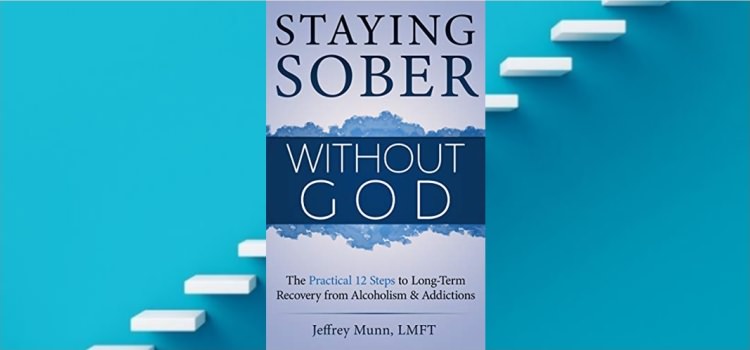
AA Version: Sought through prayer and meditation to improve our conscious contact with God as we understood Him, praying only for knowledge of His will for us and the power to carry that out.
Practical Version: We started meditating.
Throughout this process, you’ll discover – if you haven’t already – that none of these steps exists in a vacuum. They all impact each other and are impacted by the others. This is particularly true for step eleven. The ultimate goal of this step is to engage regularly in the practice of mindfulness, which has been demonstrated time and again to benefit multiple areas of one’s mental health. Being mindful means being consciously aware of something (usually breath, bodily sensations, or thoughts) without judgment or resistance. The best way to practice this is through meditation, but it can be practiced throughout the day as well. I recommend utilizing both for optimal results.
There’s a reason that dozens of books (maybe even hundreds, I didn’t count) specifically about mindfulness meditation have been written in recent years. Western civilization is catching on to an ancient practice that has the power to relieve anxiety, improve patience, increase insight, reduce aggression, increase impulse control, improve sleep, and more11. If it sounds too good to be true, that’s because there’s a catch: it’s not exciting – at least not at first. Initially, practicing mindfulness meditation feels weird and unnatural, and that’s because, for many of us, it is. The last thing our racing minds want is for us to be in the moment. Our minds want us drinking, smoking, worrying, watching TV, playing video games, socializing, working, sleeping, etc. Mindfulness meditation flies right in the face of our mind’s baser instincts and forces us to step out of the raging current that is our thoughts.
In the original version of this step, meditation is seen as a way to improve your conscious contact with God, thus helping you get in touch with what God’s “will” is for you. Obviously, that is not what the practical version is about. The results are similar, but I’m obviously chalking them up to a psychological change rather than divine intervention. While you probably won’t hear the voice of the creator of the Universe, regular mindfulness meditation can help you develop your intuition: that “gut” feeling you get that tells you what to do in a given situation. It is my personal belief that this is what the more religious members of 12-step programs are calling “God.” Unfortunately, assigning this phenomenon to a deity further promotes the idea that we are not capable of making wise, healthy choices without the help of a divine being. I have a more empowering take: we can sharpen and refine our insight and intuition by engaging in a practice that helps us think clearly and efficiently without being overwhelmed by our emotions or repetitive thoughts.
Our brains are phenomenally complex organs. It truly is mind-boggling to consider just how much is happening in there. We take in sensory input, analyze it, and respond to it in fractions of a second. We’re capable of making memories, problem solving, projecting into the future, intuiting the emotions of others, and creating fantasies. When it comes to the incredible things our brains can do, the list is practically endless. That being said, we also have areas of our brain that are, to put it bluntly, pretty stupid in comparison. Primarily, these are older parts of our brain such as the brain stem, often referred to as our “reptilian brain” and the limbic system, which includes the amygdala (fight-or-flight response), hypothalamus (hormone regulation), hippocampus (memory), in addition to multiple other structures that it would take a textbook to explain in detail. The point is that these “lower” parts of our brain, when activated by stress or anxiety, can often override the “higher” parts of our brain involved in critical thinking, planning, and working memory12.
Our fight-or-flight response did us a lot of good way back when running away from lions, tigers, and bears was a common occurrence and a high priority. We would perceive a threat, our amygdala would tell our hypothalamus to activate our sympathetic nervous system (heavy breathing, rapid heartbeat, increased blood flow) and we would either fight the threat or get the heck outta Dodge13. Nowadays, however, our brain mistakes perceived threats such as work deadlines, social rejection, worst-case scenario fantasies, and the expectations of others for current threats to our well-being. The end result is that many of us are in a near-constant state of fight-or-flight. In turn, our more rational brain is compromised and we make more impulsive decisions, struggle to regulate our emotions, and seek external means of soothing ourselves (drugs, sex, junk food, TV, etc.)
This is all a bit of an oversimplification, but the moral of the story is that we need to spend more time residing in our higher brain and less time residing in our lower brain. And how do we do that? By exercising our higher brain. As a result of doing this regularly, we will still be able to notice and acknowledge our raw emotions and impulses (in fact, we’ll become even more aware of them), but we will not immediately react to them or take them as seriously as we did before. We’ll be able to observe the more automatic parts of our mind from a distance. This doesn’t mean that we’re suppressing or avoiding them, we just aren’t letting them become us. This will make more sense as you practice. If you’ve never meditated before, this may all sound like airy-fairy nonsense, and that’s OK. Give it a try and you’ll get to experience it yourself.
Although it may seem like I’m disparaging human emotions, that’s not my intention. Our emotions are extremely important and can give us good insight into what’s going on with us and what actions we need to take in response. The problem is that our emotions often have far too much control over how we ultimately decide to behave. We aren’t looking to separate ourselves from emotions, but rather to manage them gracefully and give them a healthier role in our lives. When we feel anger, it’s often a sign that someone is mistreating us. If we are mindful, we can notice the anger and make a decision to address the problem. If we aren’t mindful, our anger may turn to rage and cause us to engage in impulsive, destructive behavior that only makes the situation worse. Emotions have a necessary place in our lives; they aren’t “good” or “bad.” Emotions are information that tell us something about what we need. The damage occurs when we act solely based on emotions rather than observing them and using the higher functions of our brain to decide how to manage them.
The results of regular meditation differ depending on how often you do it, how much you’ve done it in the past, how stressed you are, your temperament, and several other factors. Some people report that a meditation practice is nothing short of life changing, while others report results that are still positive, but less dramatic. One of my favorite books on this subject is 10% Happier by Dan Harris. In it, he describes his life as a news anchor and the regular stress that led to an eventual panic attack live on the air. This incident motivated him to find a solution to his anxiety, and he discovered mindfulness meditation. The book is titled as such because Harris claims that this regular practice hasn’t necessarily revolutionized his life, but has made him 10% happier, which he considers worth the effort. He also has a podcast named after the book which I highly suggest you take a listen to.
It’s clear that meditation is helpful for just about everyone, but why is it that it’s one of the tools recommended specifically for recovering addicts? If you recall the earlier chapter on addiction, a major factor in our compulsive behavior is the sub- or semi-conscious desire to soothe ourselves due to a persistent state of discomfort or unease. Through mindfulness meditation, we become more aware of this underlying sense of discomfort and actually begin to desensitise ourselves to it. Much as a person with a snake phobia gets better from being gradually exposed to snakes, we are practicing sitting in and accepting our general feeling of discontent. The paradoxical effect of accepting it and exposing ourselves to it is that it tends to get better and can even vanish completely. While I know that sounds great, be careful of developing expectations. It may happen or it may not. Acceptance is about not having your own agenda, but accepting everything as it is now.
Working Step Eleven
The instructions are in the step itself. For this step, all you have to do is meditate. There are several different forms of meditation, and all of them can be beneficial. However, the form of meditation that has the most current research behind it is mindfulness meditation. This chapter will be a crash course that should be enough to get you started, but there is much, much more to learn if you want. As I said before, there are countless books available on the subject. In addition, there are guided meditations all over the Internet that allow you to jump right in without any previous experience. One of my favorite sites is marc.ucla.edu. It’s the website for the Mindful Awareness Research Center at UCLA. They offer quite a few guided meditations that you can listen to for free on their website. There is absolutely no religiosity or supernatural belief incorporated into them.
When it comes to meditation, the truth is that more is almost always better. The more you meditate, the more tuned-in you will be to your inner world and the thoughts and feelings that drive you. That being said, we all have lives and limited time. Ideally, you should be meditating daily for 15-20 minutes. Some people report twenty minutes twice a day as being particularly effective. At the moment, that amount of time sitting still might sound excruciating to you, so meditate for as long as you are able to. I do suggest, however, that you pick a time beforehand and stick to it, even if it’s just two minutes. If you don’t have a timer set, you’ll struggle to meditate because you’ll be too busy wondering how long you’ve been meditating.
The classic image of a person meditating is that of a robed monk sitting in the full lotus position on a round cushion (called a zafu), arms out with forearms vertical, making a strange gesture with his hands and reciting a mantra or humming. You can certainly do this if you’re so inclined, but I’m happy to say it isn’t necessary. All you need is a comfortable place to sit and a timer. Some meditators like sitting on the floor, while others (such as myself) are a bit too inflexible to sit in that position for long. If that’s you, a chair is more than OK. Some people even prefer walking meditation, which I won’t cover here, but can often be just as powerful as sitting meditation. A quick Google search will give you plenty of info to get started if you want to pursue that. However, I’d still recommend starting with seated meditation to keep things simple at first.
To begin, sit with your back straight and your head in a comfortable position, not too far forward or too far back. You want to be relaxed, but not so relaxed that you’ll fall asleep. Don’t lean back in your chair or slouch. Contrary to popular belief, meditation is not a passive practice, it is quite active and requires you to be alert and focused. After you’re seated, start your timer, close your eyes, and focus your attention on your breath. Don’t change your breathing intentionally; just observe it. Pick a few sensations to focus on, such as your chest rising and falling or the cool sensation of air entering your nostrils. Do your best to focus all of your attention on nothing but your breathing. If you’re able to do this for more than a second or two without your mind wandering, I am in awe of your skills.
While you’re meditating, your mind will wander. Another common misconception about meditation is that “successful” meditation should result in a “clear mind,” or a mind with no thoughts. The truth of the matter is that this experience is extremely rare, especially for beginners. As I said before, our mind does not want to stay still; it wants to jump around and make a lot of noise, which is why it is often referred to by mindfulness practitioners as the “monkey mind.” Do not be discouraged when your mind wanders. That is an essential part of meditation and something even the most advanced practitioners experience. All you need to do when this occurs is notice that you’ve been distracted and direct your attention back to the breath.
Every time you direct your attention back to the breath, think of it as lifting a weight. Each time you do it, your attention muscle is getting a little bit stronger. You are getting a little more practice at staying in the moment despite your mind’s relentless efforts to pull you away from the here and now. This will happen a lot in the first few minutes of meditation, and will slowly quiet down as your session progresses. Some days you might notice very few thoughts, while other days you’ll feel like there is no hope of ever shutting your mind up. All veteran meditators have experienced both ends of the spectrum many, many times. Don’t give up. If you happen to get to a point where you are truly free of thought, congratulations! You’ve reached enlightenment. Please write a book because I want to read it.
As you get a little more comfortable meditating, you can also try labeling your distractions briefly before turning your attention back to your breath. For example, if you find yourself worrying about an upcoming job interview, you can just gently label it “worry” in your mind and then refocus your attention. It’s probably best to wait until you’re somewhat experienced with focusing only on the breath before you incorporate labeling. When you do incorporate it, however, you’ll likely find that it’s a useful tool when it comes to learning more about your thought patterns. You may notice that you think about your social life way more than you thought you did, or you may find that 99.99% of your thoughts are self-centered, or you may just notice that you’re a judgmental a-hole. Regardless, if you spend a good deal of time observing the circus that is your thinking, it’s going to be darn near impossible to not learn a few things about yourself. If those things happen to be things you don’t like, we already know how to start changing them (hint: steps six and seven).
Any amount of meditation will be beneficial in some way. Some is always better than none. With that being said, I strongly encourage you to try and do more. Many people report that they don’t even feel fully “in” their meditation until they’ve hit the 20-minute mark. Even if you don’t do it daily, pick one day a week where you take the time to do a long meditation session. There are significant changes that occur in your subjective experience after a sustained period of focused attention. The longer you do it, the more you’ll be able to notice some of the subtler thoughts that creep their way into your consciousness. You may remember things you haven’t thought of in years or have deep realizations about the way your mind works. You get out what you put in. If you meditate one minute a day, you’ll get some benefits, but you’ll only get one minute a day’s worth.
As you get better and better at meditation, you may find yourself wanting to venture into more advanced techniques or other forms of meditation such as loving-kindness or metta, which is excellent for developing compassion. Mindfulness meditation also has its own progression. Practitioners traditionally start with the breath as a focal point and then eventually move on to focusing on bodily sensations, thoughts, and finally our entire field of awareness. If you take a liking to this meditation thing, there are multiple ways to explore it further such as joining meditation groups, retreats, and even smartphone apps.
You may also be wondering, “can’t I just forget all this silliness and listen to music with my eyes closed?” Sure you can. You’re not meditating “incorrectly” if you use meditation specifically to relax and calm yourself down. Sometimes we just don’t have it in us to focus for extended periods of time on a single stimulus. If you’re feeling resistant to mindfulness meditation, by all means, grab a pair of headphones and listen to some music in a dark room or head on over to myNoise.net (I have no financial connection with that site, it’s just plain awesome) and listen to different ambient sounds while you sit quietly. Just don’t give up on mindfulness completely. While relaxation has many benefits, the specific practice of mindfulness offers unique benefits that may not be as easily obtained by other means.
Needless to say, this topic can get pretty in-depth and complicated. The basics, however, are very simple and straightforward: find a time each day to sit down and practice mindfulness meditation for anywhere from a minute to an hour. The more time you dedicate to it, the more benefits you’ll see. In addition, regular practice will result in longer-lasting changes. If you meditate today, you may feel different today, but if you meditate every day for several weeks, months, or years, you’ll likely notice lasting changes that persist outside of active meditation. Meditation can lead to altered states, while a long-term meditation practice can lead to altered traits such as increased calmness, improved emotional regulation, and a mental shift in regards to how one relates to thoughts and feeling14. Altered states are delightful, but what we’re ultimately after in recovery (and in life) is altered traits that stick with us and improve our life and the lives of those around us.
It’s time to move on to step twelve. But first, sit down and meditate.
For an excellent review of the book, click here: Staying Sober Without God.
Jeffrey Munn was born in Southern California where he still resides with his wife and daughter. He is a licensed marriage and family therapist and has been working in the field of mental health since 2010.
Jeffrey works as a therapist in private practice and specializes in addiction, OCD, and anxiety disorders. In addition to his master’s degree in clinical psychology, Jeffrey earned a degree specialty in co-occurring disorders.
Click here to access the book on Amazon: Staying Sober Without God.
To visit Jeffrey’s website, click here: Practically Sane.

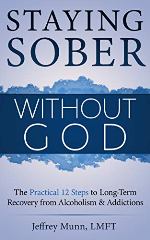

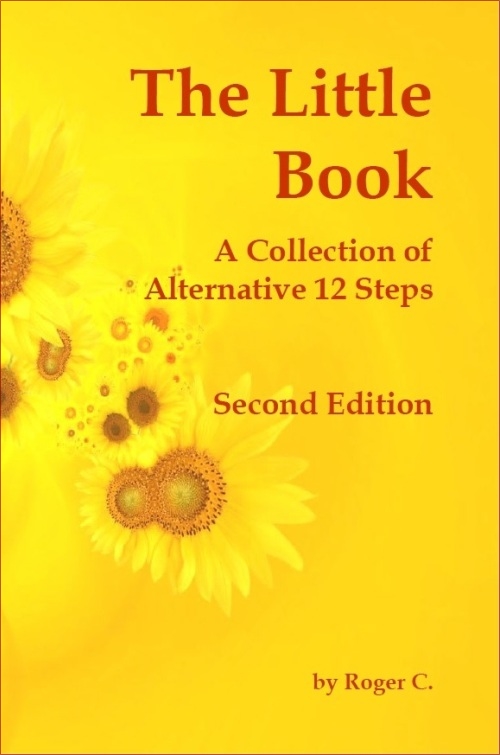

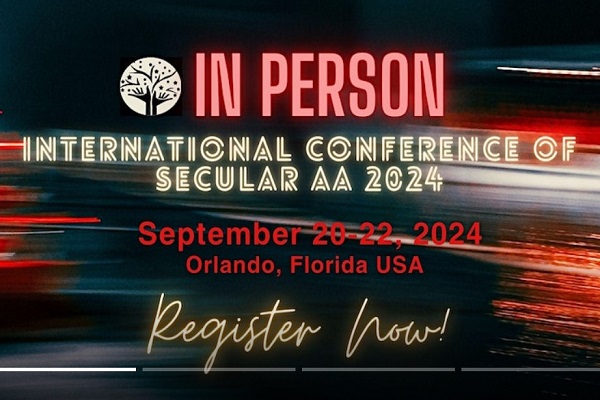


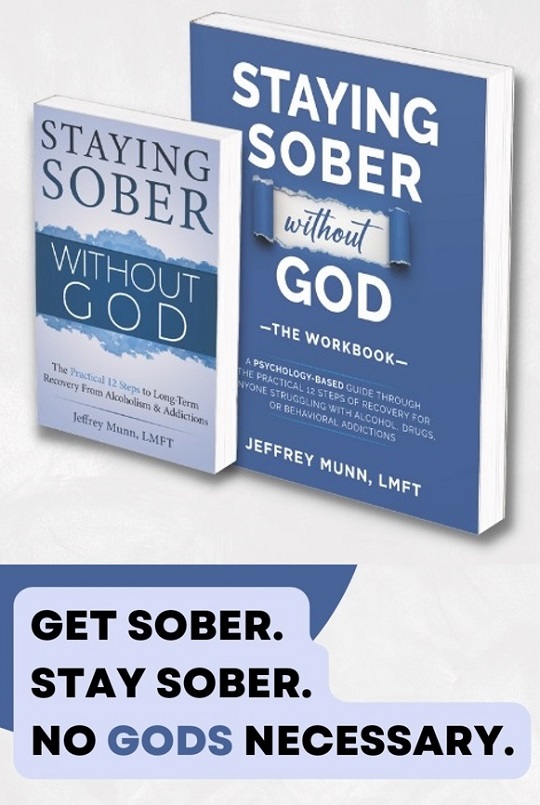
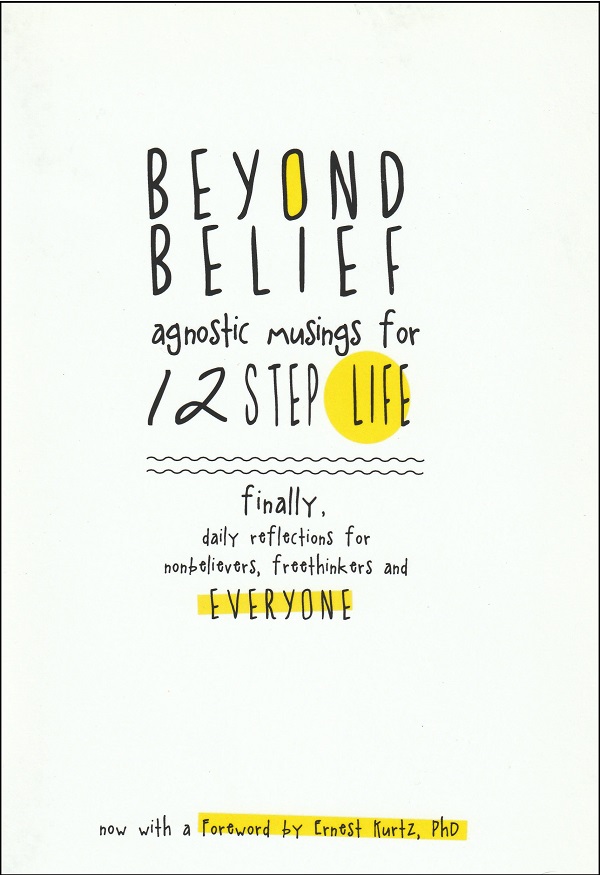


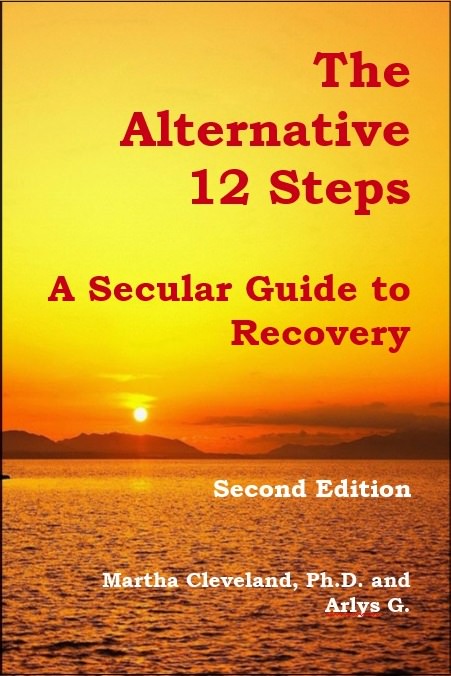













I came to AA 46 years ago a confirmed atheist. I was appalled by theology but saw the word meditation in the 11th step and started doing it and have continued to this day. I go to Refuge Recovery, the non theological Buddhist based program, which is AA without God.
I still go to AA but to fewer meetings because it saved my life, at least my version of it.
This is very well-presented. I also am Refuge Recovery, and the guided meditations on the site are very powerful. I also recommend “Why Buddhism is True” which is actually about mindful meditation and explains those protective impulses as a result of evolution.
The week I stopped drinking, I started with an online app. I was lucky to be able to do ten minutes. If you are just beginning, be kind to yourself, have no expectations, and increase your time as it feels natural.
A very good article, it presents the basics of mindful meditation very well, thank you.
At about year 5 in AA I was approaching a breaking point in traditional meetings… working harder and harder, and just getting more and more frustrated and antsy. Then I discovered AA Agnostica and mindful meditation in quick succession.
Finding the agnostic AA society pulled me out of the immediate slump, almost instantly. Meditation has made a deeper, longer lasting change.
It was accidental. A friend suggested we go try some meditation with a local Shamballa group. Like most people, I thought I knew what meditation was, maybe just being quiet and thinking deeply… only a fuzzy idea. Once exposed to some discipline and practice, it just became part of my life.
Now I do 20-30 minutes every evening, and more during the day, “as needed” like it says on the medicine bottle. After five years, the calming and stabilising influence has been profound. If you haven’t tried it, by all means give it a whirl, and like the article says, start slow and just see what happens. You may be amazed.
Thanks for this, Jeff. 2 ideas really useful, if I got it straight:
– prayer works for some not because some supernatural entity responds, but because it leads to greater intuition/insight (note the “in”);
– emotions as information, letting us know something’s amiss and we should attend to it. Again, it may well be something internal, even if we’re reacting to something happening outside.
Having both ADHD and too much anxiety, meditation has never caught on with me, and your article encourages me to use Covid-19 idleness/isolation as an opportunity to try again.
I’ve read this book and highly recommend it. We added it to our lit collection at my home group. I began practicing mindfulness meditation a few years ago and find it very helpful. It seems to calm me down and help me focus. That may mean I’m just a calmer, more focused asshole, but if that’s the case I’ll take it 🙂
I’ve now been sober for 51 years. As an atheist, I’ve found meditation to be a useful practice at times. There have been times when I’ve done meditations with a group, both AAs and Buddhists, and times when it has been a solo experience. I’ve done meditations in Native American sweatlodges and while sitting alone in the woods. All in all, meditation is not a single, mechanical thing, but a practice that helps clear and heal the mind.